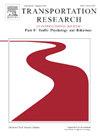“这只是另一辆汽车在行驶”——美国居民在公共道路上与无人驾驶自动驾驶汽车互动的看法
IF 3.5
2区 工程技术
Q1 PSYCHOLOGY, APPLIED
Transportation Research Part F-Traffic Psychology and Behaviour
Pub Date : 2025-03-11
DOI:10.1016/j.trf.2025.01.024
引用次数: 0
摘要
无人驾驶,SAE 4级自动驾驶汽车(AVs),即无人驾驶车辆,已经在美国的一些城市投入使用。自动驾驶汽车的驾驶风格和行为会导致道路使用者在交通中与自动驾驶汽车互动的行为发生变化。之前的研究没有收集到居住在自动驾驶汽车部署区域的道路使用者的数据,也没有收集到那些通过定期与自动驾驶汽车互动而对自动驾驶汽车有丰富经验的人的数据。因此,缺乏基于扎实经验和深层原因的道路使用者对交通中自动驾驶汽车的反应的全面而丰富的分析。本研究的两个主要研究问题是:1)道路使用者在交通中对自动驾驶汽车的反应如何?2)哪些因素影响道路使用者对交通中自动驾驶汽车的反应?我们对居住在部署了无人驾驶汽车的美国城市的个人进行了半结构化访谈,以探讨道路使用者如何以及为什么对交通中的无人驾驶汽车做出反应。内容分析应用于手动识别数据中的主题,并辅以使用大型语言模型。我们还计算了Spearman秩序相关性,以确定子主题之间的显著关联。最常见的道路使用者行为是对自动驾驶汽车更加谨慎,让自动驾驶汽车通过,挥手并盯着它们看。道路使用者利用自动驾驶汽车的功能,切断它们的道路,让它们减速,或者不顾一切地在前面过马路。自动驾驶汽车安全操作员通常会监控自动驾驶汽车的运行情况,从而让人们认为自动驾驶汽车是安全的、可预测的。其他参与者报告了特斯拉SAE 2级部分自动驾驶系统的驾驶员/人工操作员不注意的事件,被观察到在自动驾驶汽车中睡觉,并追尾了我们的一名参与者。道路使用者和人类司机之间最常见的外部交流线索是目光接触,在某些情况下,也没有操作员在场。涉及自动驾驶汽车致命事故的媒体报道/个人故事,尤其是与特斯拉部分自动驾驶系统有关的事故,都与对自动驾驶汽车安全性的担忧有关。我们的研究揭示了自动驾驶汽车的行为(如自动驾驶汽车被卡住)与道路使用者在行为、认知(如信任、不信任)和情感(如感知安全、沮丧或愤怒)方面的变化之间的显著关联。更多的自动驾驶汽车在公共道路上的试验可以提高道路使用者的兴趣和好奇心,以及他们对自动驾驶汽车的接受和使用。需要进一步研究eHMIs的需求及其在促进更安全、更有效和舒适的互动方面的有效性。本文章由计算机程序翻译,如有差异,请以英文原文为准。
“It’s just another car driving” − Perceptions of U.S. residents interacting with driverless automated vehicles on public roads
Driverless, SAE Level 4 automated vehicles (AVs)—vehicles operating without on-board human operators—have become operational in some cities in the U.S. The driving style and behaviors of AVs can induce changes in the behavior of road users interacting with AVs in traffic. Prior research has not collected data from road users residing in areas in which AVs are deployed and who have solid experience with AVs by regular interactions with them. As a result, a comprehensive and rich analysis of road users’ responses to AVs in traffic based on solid experience and the underlying reasons is missing. The two main research questions of this study are: 1) How do road users respond to AVs in traffic? and 2) Which factors affect road users’ responses to AVs in traffic? Semi-structured interviews were conducted with individuals residing in U.S. cities in which driverless AVs are deployed to explore how and why road users respond to driverless AVs in traffic. Content analysis was applied to manually identify themes in the data, complemented by using large language models. We also computed Spearman rank-order correlations to determine significant associations between the sub-themes. The most common road user behaviors were being more cautious around AVs, letting the AV pass and waving and gawking at them. Road users took advantage of the capabilities of AVs, cutting them off, slowing them down, or recklessly crossing the road in front. The AV safety operators typically monitored the operation of the AV, contributing to the perception that AVs are safe and predictable. Other participants reported incidences of inattentive drivers / human operators of Tesla’s SAE Level 2 partially automated driving system, being observed sleeping in the AV and rear-ending one of our participants. The most common external communication cue between road users and human drivers was eye contact, in some cases also when there was no operator present. Media reports / personal stories involving fatal accidents with AVs, particularly those linked to Tesla’s partially automated driving system, were linked to concerns about AV safety. Our study reveals significant associations between the behavior of AVs (e.g., AV being stuck) and road users’ changes in behavior, cognition (e.g., trust, distrust) and affect (e.g., perceived safety, frustration or anger). More trials with AVs on public roads can promote the interest and curiosity of road users, and their acceptance and use of AVs. The need for eHMIs and their effectiveness in promoting safer, more efficient, and comfortable interactions needs to be further investigated.
求助全文
通过发布文献求助,成功后即可免费获取论文全文。
去求助
来源期刊
CiteScore
7.60
自引率
14.60%
发文量
239
审稿时长
71 days
期刊介绍:
Transportation Research Part F: Traffic Psychology and Behaviour focuses on the behavioural and psychological aspects of traffic and transport. The aim of the journal is to enhance theory development, improve the quality of empirical studies and to stimulate the application of research findings in practice. TRF provides a focus and a means of communication for the considerable amount of research activities that are now being carried out in this field. The journal provides a forum for transportation researchers, psychologists, ergonomists, engineers and policy-makers with an interest in traffic and transport psychology.

 求助内容:
求助内容: 应助结果提醒方式:
应助结果提醒方式:


